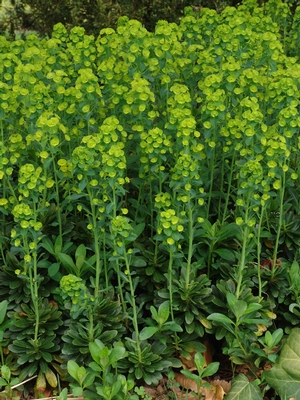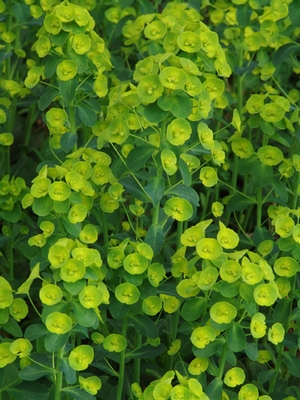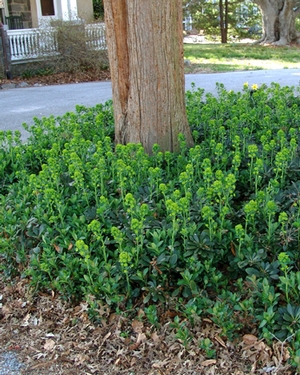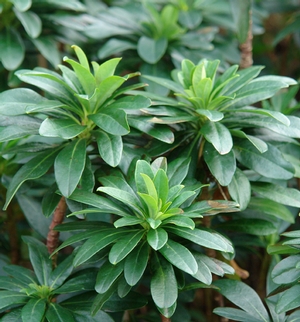Euphorbia amygdaloides var. robbiae
Common: wood spurgeEuphorbia amygdaloides var. robbiae - 50 per flat
- Height: 12"-18"
- Spread: 12"-18"
- Spacing: 12"
- Hardiness Zone(s): 5-7


Euphorbia amygdaloides var. robbiae - 50 per flat



An evergreen plant that is excellent in sun or shade. A carefree, slowly spreading groundcover with shiny, deep green, leathery leaves. Yellow green disc-like bracts back chartreuse yellow flowers in late spring which last for months. Looks fantastic in a pot and in the garden. Grow in a protected site for best winter foliage. Most importantly, this plant has just about zero maintenance requirements. Unbeatable!
E. amygdaloides var. robbiae differs from others in this species by being rhizomatous, which makes it such a useful groundcover. It will spread quicker if the soil is moist and loose with organic material. Grows in a variety of conditions, including dry shade. Wood spurge is easily propagated by division or cuttings. Useful as a dry shade groundcover or along wooded paths interwoven with more ephemeral plants.
"Many of the herbaceous, leafy species of Euphorbia are commonly called "spurges." This word derives from the Old French word espurgier (Latin expurgare), which means "to purge." The sap of many herbaceous Euphorbia species have traditionally been used as a purgative, or laxative." - PBI Euphorbia Project
"What we perceive as "flowers" are usually colored leaves or bracts at one of several levels, from the bases of the clusters to their ultimate divisions. These may remain colorful (or even grow more so) long after the flowers have passed. A feature hidden until some part of the plant is cut or broken is the milky sap, which is usually poisonous to some degree, sometimes violently so (see the plant descriptions below). Those of us engaged in pitched battles with gophers, deer and rabbits will appreciate this feature, for it makes many euphorbias nearly immune to attack. However, those of you with small children will want to wait to plant them until the age of testing each new object in the mouth has passed." - Suncrest Nurseries
Euphorbia make up of one of the largest and most diverse plant families in the world. Annuals, hardy perennials, shrubs, trees, succulents and cacti are all well represented in most countries. Their bizarre shapes, from golf-ball-like to spiny shrubs, can disguise the connection until their charming flowers show the family's floral characteristics.